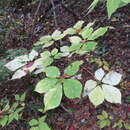en
names in breadcrumbs


Chengiopanax sciadophylloides ist ein Baum in der Familie der Araliengewächse aus Japan.
Chengiopanax sciadophylloides wächst als laubabwerfender Baum bis etwa 20 Meter hoch. Die glatte Borke ist gräulich.
Die wechselständigen und langstieligen Laubblätter sind zusammengesetzt handförmig mit 3–7 Blättchen. Der Blattstiel ist bis zu 50 Zentimeter lang. Die fast kahlen, kurz gestielten, papierigen und spitzen bis meist zugespitzten, bis zu 13 Zentimeter langen Blättchen sind eiförmig bis meist verkehrt-eiförmig und teils spitzig gesägt. Die Blättchenstiele sind bis 1,5 Zentimeter lang. Es sind Nebenblätter vorhanden. Die Herbstfärbung ist gelb.
Chengiopanax sciadophylloides ist andromonözisch, es sind also zwittrige und männliche Blüten auf einem Exemplar. Es werden endständige, rispige und vielblütige Blütenstände mit doldigen Gruppen gebildet. Die kleinen, grünlich-weißen und gestielten Blüten sind fünfzählig mit doppelter Blütenhülle. Der Kelch ist nur minimal in einem gezähnten Ring ausgebildet. Die klappigen Kronblätter sind zurückgelegt. Es sind 5 vorstehende Staubblätter vorhanden. Der zweikammerige Fruchtknoten ist unterständig mit sehr kurzem Griffel. Es ist ein Diskus vorhanden.
Es werden kleine, rundliche, seitlich etwas zusammengedrückte und zweisamige, kahle, schwarz-purpurne Steinfrüchte mit beständigem Griffel gebildet.
Die jungen Blattsprossen werden als Gemüse verwendet.
Chengiopanax sciadophylloides ist ein Baum in der Familie der Araliengewächse aus Japan.
Chengiopanax sciadophylloides is a flowering tree in the family Araliaceae native to Japan. Previously included in the genus Eleutherococcus, it is distinguished from other members of that genus by not having spines or prickles and ITS sequence data confirmed the separation.[2]
Chengiopanax sciadophylloides has been found to be a specific hyperaccumulator of manganese even in soils not contaminated with excessive amounts of manganese. In wild plants manganese concentrations of up to 23 grams per kilogram (0.37 oz/lb) of dried leaf have been analyzed.[3]
After the Fukushima Daiichi nuclear disaster in March 2011 it was found that Chengiopanax sciadophylloides accumulated the radioactive isotope Caesium-137 to concentrations above the human consumption guideline of 100 becquerels per kilogram of fresh weight even as far away as Nagano and Iwate Prefectures. Analysis of leaves taken from Chengiopanax sciadophylloides in August and October 2013 from a forest 37 kilometres (23 mi) northwest of the Fukushima Dai-ichi Nuclear Power Plant found a mean concentration of 28,100 becquerels per kilogram of dry weight, over three times those of other trees. They also accumulated the non-radioactive Caesium-133 more than other trees.[4]
Known as koshiabura (コシアブラ[5]), gonzetsu and gonzetsunoki[6] in Japanese cuisine, it is foraged in the wild in Spring for the young leaves as sansai ("mountain vegetables").[4][5][6] Called the "queen of sansai". Often used in tempura but popular in a range of dishes. The highest grade of buds is as small as a calligraphy brush and so named fude ha ("leaf of brush").[7]
A decoction of the roots, tea of the root bark, and tea of the leaf were used in the Niigata Prefecture as a folk remedy.[6]
A lacquer-like coating material called kinshitsu (金漆) used to be made from the sap.[8] The polyacetylenes in the plant sap were polymerised by sunlight to produce the hard resin varnish. Two other members of the Araliaceae, Dendropanax trifidus and Gamblea innovans, may also have been sources for this lacquer in Japan. The lacquer was used to prevent corrosion of suits of armour and helmets, with related species providing a similar lacquer used in China during the T'ang dynasty and in Korea.[9]
The wood is used for general construction and for chopsticks.[6] The wood is regarded as auspicious and is valued in the Sasano-Bori doll carving tradition in Yonezawa (along with the wood of the Pagoda Tree) for its strength and flexibility.[10]
Chengiopanax sciadophylloides is a flowering tree in the family Araliaceae native to Japan. Previously included in the genus Eleutherococcus, it is distinguished from other members of that genus by not having spines or prickles and ITS sequence data confirmed the separation.
Chengiopanax sciadophylloides é uma espécie de Chengiopanax[1][2]
Chengiopanax sciadophylloides é uma espécie de Chengiopanax
Chengiopanax sciadophylloides là một loài thực vật có hoa trong Họ Cuồng. Loài này được (Franch. & Sav.) C.B.Shang & J.Y.Huang mô tả khoa học đầu tiên năm 1993.[1]
Chengiopanax sciadophylloides là một loài thực vật có hoa trong Họ Cuồng. Loài này được (Franch. & Sav.) C.B.Shang & J.Y.Huang mô tả khoa học đầu tiên năm 1993.